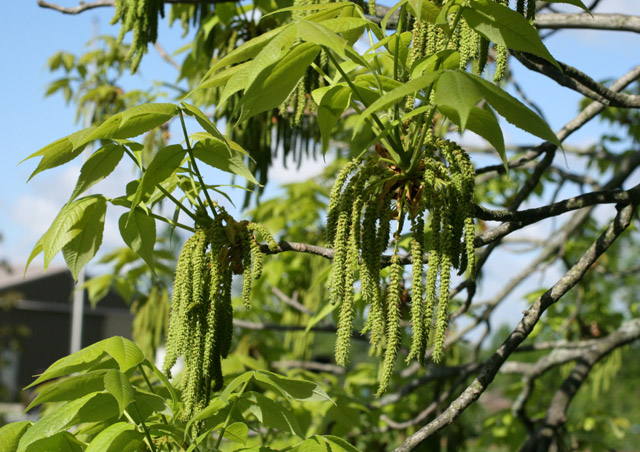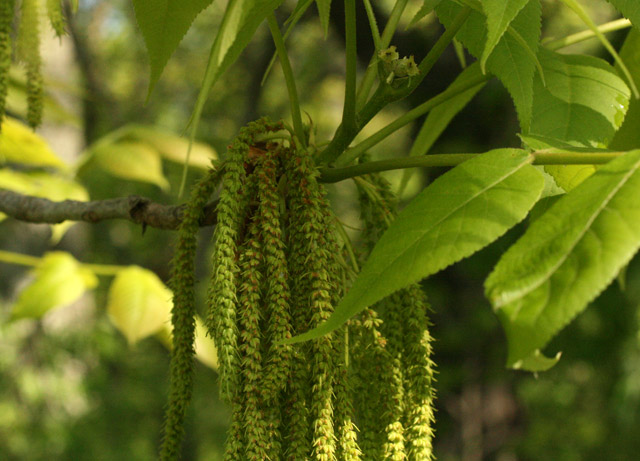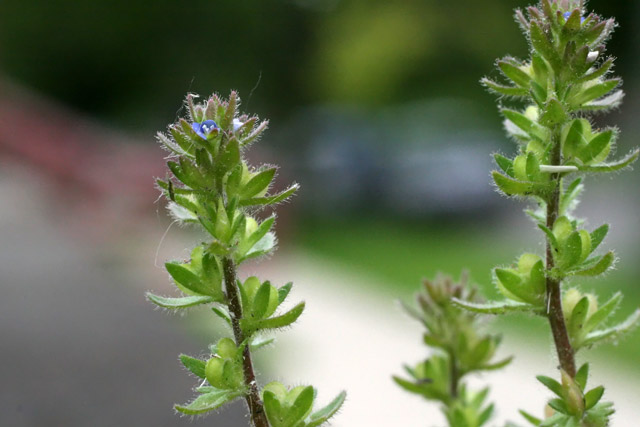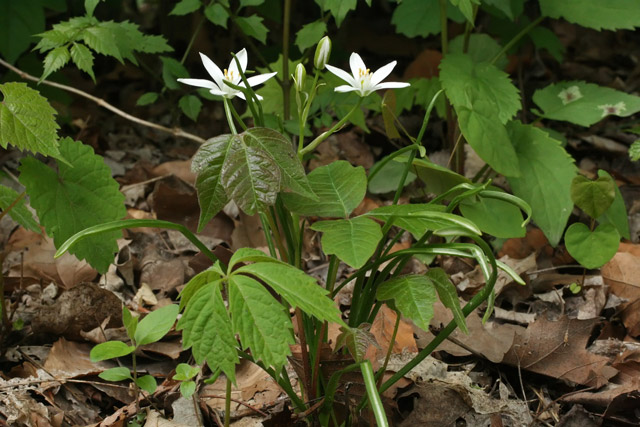Nashville and Yellow Springs Ohio
18 May 2008
Nashville, Ohio
At my friends Den and KC’s lovely 15 acre homestead in Nashville or Troy or Pigeye in Miami County OH there is a low-lying woodlot at the edge of which is a possible shellbark hickory (I find hickories a challenge to identify), Carya laciniosa, in full flower.

Shellbark hickory flowering
Nashville, Miami County, OH, May 18, 2008
Like many trees, hickories are monoecious, producing unisexual flowers separately from one another on the same tree. Hickory is wind-pollinated, and produces its inconspicuous male flowers abundantly in drooping catkins.

Shellbark hickory male and female flowers
May 18, 2008, Nashville, OH
The female flowers of hickory, while still inconspicous (wind-pollinated flowers lack colorful petals) are nonetheless larger than the tiny male ones. They have elaborate stigmas. The large surface area enhances their ability to receive pollen.

Shellbark hickory, pistillate (female) flowers,
May 18, 2008
Farther into the woods is a copse of pawpaw (Asimina triloba). These trees are of tropical affinity, the northernmost representatives of their family (Annonaceae, the custard-apple family). They grow in clones of several to many small trees connected underground.

Pawpaw flower and young leaves
May 18, 2008, Miami County, OH
The flowers are bisexual (hermaphroditic), containing both stamens and carpels. They are self-incompatable, an adaptation that enhances genetic diversity among the offspring (or avoids inbreeding depression, essentially the same effect).

Left: foreground petals and sepals removed to show globe-like cluster of stamens and protruding carpels.
Right: Immediately after flowering, very young fruits remain on the pedicels.
This garter snake (Thamnophis sp., either the eastern garter snake, T. radix, or a Butler’s garter snake, T. butleri (can it be identified from the pictures?) avoided perceived predatory capture by probing primates by hiding in the grass and musking enthusiastically. It also made scary efforts to strike. Garter snakes are common in the pet trade. They make excellent pets, and are mostly bred, not captured. By his size, we judged it to be a neonate. There is a pond nearby that has tadpoles, a good possible food source.

Garter snake in the grass
May 18, 2008, Miami County, OH.

Garter snake in the grass
May 18, 2008, Miami County, OH
May 17, 2008
Yellow Springs, Ohio
Today we went to Yellow Spings Ohio to buy books, CD’s and LP’s at the WYSO “garage sale.” It was located on the campus of the seemingly sadly sinking Antioch College. On an unkempt lawn (the best kind) next door to the studio there is a thriving population of star-of-Bethlehem (Ornithogalum umbellatum, family Liliaceae).

Star-of-Bethlehem as a lawn weed,
May 17, 2008, Yellow Springs, Greene County, OH
The speedwells (genus Veronica, family Scrophulariaceae) differ from most other snapdragon family members by having a corolla (petals, considered collectively) that is nearly symmetrical, and bearing only two stamens. They are generally inconspicuous herbs, the most inconspicuous of which is the tiny-flowered “field speedwell,” V. arvensis.

Field speedwell growing in crack in masonry wall
Yellow Springs, OH, May 17, 2008

Field speedwell in flower and fruit. Notice the heart-shaped capsules on the right-hand stem.
Poison-ivy (Toxicodendron radicans) and Virginia creeper (Parthenocissus quinquefolia) are rather similar in many respects, although only one of them causes an allergic reaction in many people. Both are extremely common woody vines with alternately arranged compound leaves, and both can be found on the ground or climbing trees. It’s fun to see them side-by-side, as in the picture below. (The Virginia creeper, which has 5 leaflets, is situated below the poison-ivy, which has 3 leaflets.)

Poison-ivy and Virginia creeper
Yellow Springs, OH, May 17, 2008
